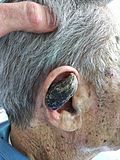Cutaneous horn
Editor-In-Chief: Prab R Tumpati, MD
Obesity, Sleep & Internal medicine
Founder, WikiMD Wellnesspedia &
W8MD medical weight loss NYC and sleep center NYC
| Cutaneous horn | |
|---|---|
| Synonyms | Cornu cutaneum |
| Pronounce | N/A |
| Specialty | N/A |
| Symptoms | Hard, conical projection on the skin |
| Complications | Squamous cell carcinoma, basal cell carcinoma, melanoma |
| Onset | Varies |
| Duration | Persistent until treated |
| Types | N/A |
| Causes | Actinic keratosis, wart, seborrheic keratosis, keratoacanthoma |
| Risks | Sun exposure, human papillomavirus infection |
| Diagnosis | Physical examination, biopsy |
| Differential diagnosis | Wart, actinic keratosis, seborrheic keratosis, keratoacanthoma |
| Prevention | N/A |
| Treatment | Surgical excision, cryotherapy, curettage |
| Medication | N/A |
| Prognosis | Good with treatment |
| Frequency | Rare |
| Deaths | N/A |
Cutaneous horn is a type of skin lesion that resembles the horn of an animal. It is a conical, dense, and hyperkeratotic protrusion that can vary in size from a few millimeters to several centimeters. Cutaneous horns are most commonly found in areas exposed to sunlight, such as the face, ear, and back of the hands.
Causes
Cutaneous horns are caused by the overgrowth of the top layer of skin, known as the epidermis. This overgrowth can be triggered by a variety of factors, including sun damage, human papillomavirus (HPV), and certain skin conditions such as actinic keratosis and seborrheic keratosis. In rare cases, cutaneous horns can be associated with skin cancer.
Symptoms
The primary symptom of a cutaneous horn is a hard, thickened area of skin that protrudes outward. The horn may be yellow, brown, or gray in color, and its surface may be smooth or rough. Some people may experience pain or discomfort, especially if the horn is located in an area that is frequently touched or rubbed.
Diagnosis
Diagnosis of a cutaneous horn is typically made through a physical examination. In some cases, a biopsy may be performed to rule out underlying conditions such as skin cancer.
Treatment
Treatment for cutaneous horns typically involves removing the horn and the underlying cause. This can be done through various methods, including cryotherapy, surgery, or topical medications. In cases where the horn is associated with skin cancer, additional treatments such as radiation therapy or chemotherapy may be necessary.
Prevention
Prevention of cutaneous horns involves protecting the skin from sun damage. This can be achieved by wearing protective clothing, using sunscreen, and avoiding excessive sun exposure.
Gallery
See also
Transform your life with W8MD's budget GLP-1 injections from $125.
W8MD offers a medical weight loss program to lose weight in Philadelphia. Our physician-supervised medical weight loss provides:
- Most insurances accepted or discounted self-pay rates. We will obtain insurance prior authorizations if needed.
- Generic GLP1 weight loss injections from $125 for the starting dose.
- Also offer prescription weight loss medications including Phentermine, Qsymia, Diethylpropion, Contrave etc.
NYC weight loss doctor appointments
Start your NYC weight loss journey today at our NYC medical weight loss and Philadelphia medical weight loss clinics.
- Call 718-946-5500 to lose weight in NYC or for medical weight loss in Philadelphia 215-676-2334.
- Tags:NYC medical weight loss, Philadelphia lose weight Zepbound NYC, Budget GLP1 weight loss injections, Wegovy Philadelphia, Wegovy NYC, Philadelphia medical weight loss, Brookly weight loss and Wegovy NYC
|
WikiMD's Wellness Encyclopedia |
| Let Food Be Thy Medicine Medicine Thy Food - Hippocrates |
Medical Disclaimer: WikiMD is not a substitute for professional medical advice. The information on WikiMD is provided as an information resource only, may be incorrect, outdated or misleading, and is not to be used or relied on for any diagnostic or treatment purposes. Please consult your health care provider before making any healthcare decisions or for guidance about a specific medical condition. WikiMD expressly disclaims responsibility, and shall have no liability, for any damages, loss, injury, or liability whatsoever suffered as a result of your reliance on the information contained in this site. By visiting this site you agree to the foregoing terms and conditions, which may from time to time be changed or supplemented by WikiMD. If you do not agree to the foregoing terms and conditions, you should not enter or use this site. See full disclaimer.
Credits:Most images are courtesy of Wikimedia commons, and templates, categories Wikipedia, licensed under CC BY SA or similar.
Contributors: Prab R. Tumpati, MD







